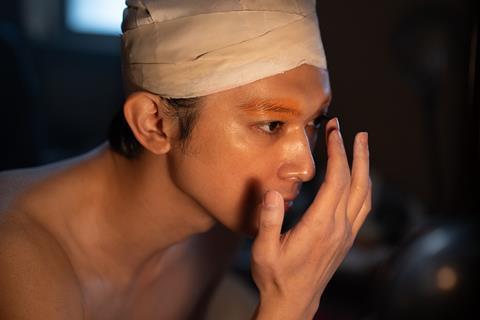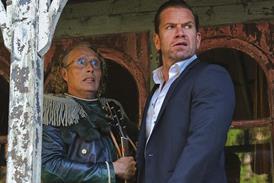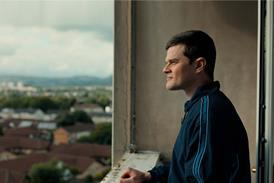Ken Wanatabe, Ryusei Yokohama and Soya Kurokawa star in Japan’s Oscar submission, which closes Bangkok

Dir: Lee Sang-il. Japan. 2025. 174mins
People from opposite sides of the social spectrum becoming friends and professional rivals is a familiar premise but, when approached with a technical polish or from a fresh perspective, it makes for engrossing storytelling. Such is the case with Korean/Japanese director Lee Sang-il’s Kokuho, which follows the orphaned son of a Yakuza boss who is taken in by a renowned actor and trained alongside the man’s son in the art of onnagata – men playing women’s roles in kabuki theatre. Despite almost becoming bogged down in melodrama in its second half, the film immerses viewers in this world in ways that are both intimate and cinematic.
Immerses viewers in this world in ways that are both intimate and cinematic
Since breaking out with his 2004 coming-of-age comedy 69, Lee has earned a reputation for turning a critical eye on Japanese society. Kokuho is his third adaptation of a Shuichi Yoshida novel, following Japanese Academy prizewinners Villain (2010) and Rage (2016). Following its premiere in Cannes’ Directors’ Fortnight, the film has played festivals including Toronto, Busan and Bangkok, and has earned over JPY16bn (US$107m) in Japan since its June release – second only to Demon Slayer: Infinity Castle. It has also been selected as Japan’s official Oscar entry. Sumptuous production design, tactile cinematography and committed performances should carry the film to strong art house showings in Asian markets and overseas (Gkids will release in the US), and on to niche streamers.
Kokuho recalls Chen Kaige’s Farewell My Concubine in the way it frames its core story about the ebb and flow of a decades-long friendship, and artistic competition within an exacting art form that can be alienating for the uninitiated. To their credit, Lee and screenwriter Satoko Okudera (Kiki’s Delivery Service) have made the brutal precision and artistry of kabuki accessible, often by using the form’s most famous plays as a metaphor for the central friendship, while still capturing the emotional essence of the source novel.
In 1964 Nagasaki, yakuza boss Gongoro Tachibana (Masatoshi Nagase) is hosting a banquet in order to assure kabuki theatre star Hanai Hanjiro (Ken Watanabe, steely and imposing) that he is safe in the city, as well as show off his 14-year-old son Kikuo’s (Soya Kurokawa) onnagata skills. After a rival gang murders Tachibana, Hanjiro takes Kikuo as an apprentice and relocates him to Osaka. By the following year, Kikuo and Hanjiro’s 14-year-old son and heir Shunsuke (Keitatsu Koshiyama) are fast friends and kabuki partners – Shunsuke’s place as the next great actor of the Hanjiro dynasty is, after all, guaranteed by birthright, and he faces no threat from the orphaned son of a criminal.
By 1972, however, the confident Shunsuke (now played by Ryusei Yokohama of Lee’s Wandering, Unreachable) has become complacent, while Kikuo (Ryo Yoshizawa, Tokyo Revengers, Living In Two Worlds) has devoted himself fully to the stage. Their bond comes under pressure when Hanjiro breaks his leg before a crucial performance and he taps Kikuo to take his place in the lead role. Years later, he breaks with tradition to name Kikuo as Hanjiro’s successor, putting the so-called outsider on the road to status as ningen kokuho; living national treasure.
Unspooling over a well-paced three hours, Lee is in no hurry to get to the inevitable conclusion, opting instead to linger in the little moments that shape these young men – Hanjiro’s abusive training, hitting upon their signature duet. He also luxuriates in the details that bring the world of kabuki into stark relief via Yohei Taneda’s lush production design and Kumiko Ogawa’s (Kill Bill) intricate costumes. (Kabuki star Nakamura Ganjiro IV’s was on board as an advisor.) Tunisian cinematographer Sofian El Fani (Pachinko, Blue Is The Warmest Color) alternates between tight close-ups capturing caked make-up under hot spotlights and cluttered backstage spaces, and sweeping wide angles that demonstrate the grandiosity of kabuki and its shifting position within Japanese culture over 50 years – as well as Kikuo’s flagging fortunes.
The flawless technical work provides graceful support to the themes of legacy, misogyny and the power of patronage that lurk in the periphery of the story, revealed in Yoshizawa and Yokohama’s nuanced turns as Kikuo and Shunsuke. The actors studied kabuki for a year and have built an effortless dynamic whose private relationship with each other and with kabuki comes at the unapologetic expense of all others – including wives and children. As if fulfilling a prophecy, the women in Kokuho are of so little consequence that none gets any chance to create characters of their own, with the exception of Shinobu Terajima as Shunsuke’s conflicted mother.
The film’s focus is squarely on Kikuo and Shunsuke, and the artform they embody. And by the time the film comes to rest on Kikuo’s enveloping final performance, weaving together traditional kabuki rhythms and pounding modern orchestration, even novices will feel as though they have been given a glimpse at some of an art – and a nation’s – most enduring mysteries.
Production companies: Aniplex
International sales: Pyramide International, sfouque@pyramidefilms.com
Producers: Chieko Murata, Shinzo Matsuhashi
Screenwriter: Satoko Okudera, based on the novel by Shuichi Yoshida
Cinematography: Sofian El Fani
Production design: Yohei Taneda
Editor: Tsuyoshi Imai
Music: Marihiko Hara
Main cast: Ryo Yoshizawa, Ryusei Yokohama, Ken Watanabe, Shinobu Terajima, Mitsuki Takahata, Min Tanaka, Soya Kurokawa, Keitatsu Koshiyama















![[Clockwise from top left]: Paul Thomas Anderson, Chloe Zhao, Ryan Coogler, Park Chan-wook](https://d1nslcd7m2225b.cloudfront.net/Pictures/274x183/9/0/0/1467900_writerdirectors_192733.jpg)






